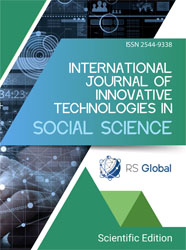THE WAYS OF MOTIVATION OF EFFECTIVENESS OF VERBAL AND NON-VERBAL COMMUNICATION
Abstract
This article is devoted to the study of motivational means used to ensure the effectiveness of verbal and non-verbal communication. As we know, one of the most urgent problems of modern psycholinguistics is the problem of an adequate description of human language ability. In fact, all research conducted in the field of psycholinguistics is devoted to this goal - the problem of an adequate description of human language ability. Building a theoretical model that represents the nature of human language ability involves analyzing empirical material at three levels: first, at the level of characteristics of the means a person uses to realize language ability; second, the characteristics of the systems on which these means operate; thirdly, the characteristics of the psychophysiological mechanism of these processes (of course, incomplete). The first level is purely linguistic. At present, the means used by speakers of different types of languages in the communication process are described in sufficient detail; There are several descriptions of the ontogenetic development of language tools. Little is known about the formation of psycholinguistic mechanisms of the communicative function of language. From this point of view, the research studies that examine the characteristics of the formation of means of communication from the non-verbal period to the emergence of conditional communication signs are very promising. In this article, along with verbal communication, information about non-verbal communication is provided, and the opinions of different linguists about verbal and non-verbal communication are analyzed and studied. A number of motivational means are used to increase the efficiency of verbal and non-verbal communication. It should be noted that communicators’ physiological, psychological, and intellectual levels should be considered when applying these motivational means. We have tried to pay attention to these issues in this article
References
Bakhtin, M.M. (1979). The problem of speech genres // Aesthetics of verbal creativity. Moscow.
Bally, Sh. (1955). General linguistics and questions of the French language. Moscow.
Darwin, Ch. (1908). Illustrated collection of essays in 8 t. T. 3. Moscow.
Filippov, A.V. (1975). Sound language and «language» of gestures // Linguistic collection. III. Moscow. MOPI, pp. 14-33.
Hall ET. (1959). Silent language. N.Y.: Doubleday & Co. 240 p.
Hamperts, Dzh. (1975). Типы языковых общество (New in Linguistics. Issue VII. Sociolinguistics. Moscow. Pp. 182-198.
Kolshansky, G.V. (1974). Paralinguistics. Moscow. Nauka.
Maslow, A.Kh. (2008). Motivation and personality, St. Petersburg: Peter, 352 p.
Melnikov, G.P. (1989). Communicative perspective - the basis of semantic and grammatical peculiarities of the language as a pictorial sign system // Methodology of Linguistics and Aspects of the Study of Language. Moscow. UDN, Pp. 11-26.
https://studref.com/590461/menedzhment/modeli_kommunikatsiy [Accessed: 29 July, 2022]
Functionalism B. Malinovskogo [Electronic resource]//Fond znaniy «Lomonosov». URL:http://www.lomonosov-fund.ru/enc/ru/encyclopedia:0128384 [Accessed: 20 December, 2021]
Views:
1071
Downloads:
728
Copyright (c) 2022 Adila Mehrali Farzaliyeva

This work is licensed under a Creative Commons Attribution 4.0 International License.
All articles are published in open-access and licensed under a Creative Commons Attribution 4.0 International License (CC BY 4.0). Hence, authors retain copyright to the content of the articles.
CC BY 4.0 License allows content to be copied, adapted, displayed, distributed, re-published or otherwise re-used for any purpose including for adaptation and commercial use provided the content is attributed.











